Southeastern Indiana: Realtors Region 6 Profile
Figure 1: Southeastern Indiana: Realtors Region 6
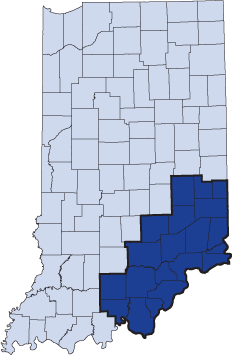
Source: IBRC, using the Indiana Association of Realtors definitions
Realtors Region 6 consists of 20 counties in the southeastern portion of the state and has a population of 671,602 as of 2009. Counties in this region include Bartholomew, Clark, Crawford, Dearborn, Decatur, Fayette, Floyd, Franklin, Harrison, Jackson, Jefferson, Jennings, Ohio, Orange, Ripley, Rush, Scott, Switzerland, Union and Washington (see Figure 1).
This region covers a significant land area of 6,676 square miles. Converting that to population density, the region has 101 residents per square mile. That’s higher than the national average of 88 people but much lower than the Indiana average of 179 people per square mile.
Population
The largest city in Realtors Region 6 is Columbus, with a 2009 population of 40,308. The city of New Albany comes in a close second, with a population estimate of 37,517 (see Table 1).
Table 1: Largest Cities in Region 6, 2009
| Name | Population | Percent of Region |
|---|---|---|
| Columbus | 40,308 | 6.0% |
| New Albany | 37,517 | 5.6% |
| Jeffersonville | 32,981 | 4.9% |
| Clarksville | 22,190 | 3.3% |
| Seymour | 19,320 | 2.9% |
| Connersville | 13,834 | 2.1% |
| Madison | 12,882 | 1.9% |
| Greensburg | 10,872 | 1.6% |
| Charlestown | 7,473 | 1.1% |
| Salem | 6,463 | 1.0% |
Source: IBRC, using U.S. Census Bureau data
The region grew by nearly 32,500 people between Census 2000 and the latest estimate in 2009 (see Figure 2). The population in Realtors Region 6 is projected to continue its growth through 2015, by which time its population would be nearly 686,300 according to the official county population projections from the Indiana Business Research Center.
Figure 2: Region 6 Population Levels, 1981 to 2009
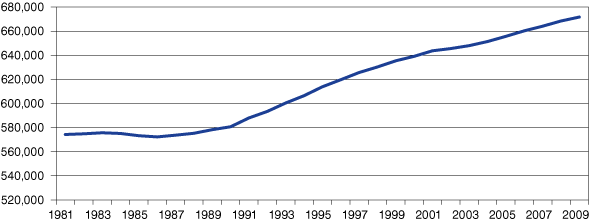
Source: IBRC, using U.S. Census Bureau data
This region has an age mix similar to the state’s (see Figure 3). Two notable differences: college age, where Region 6 has a lower proportion than the state and older adults 45 to 64, which is a higher proportion compared to the state.
Figure 3: Current Age Structure of Realtors Region 6, 2009
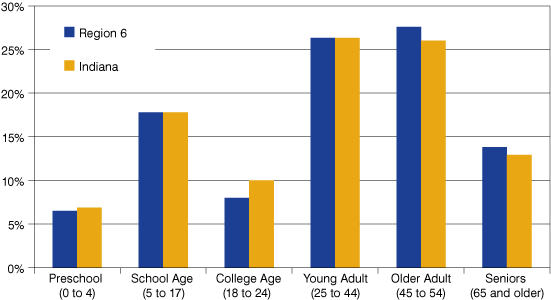
Source: IBRC, using U.S. Census Bureau data
Realtors Region 6 notably gained in net domestic migration, with 391 more people moving into the region from elsewhere in Indiana and the United States than moving out. Region 6 ranks last among the six Realtors regions in net migration from other nations, with only 544 more people moving into the region from overseas or across borders between 2008 and 2009 than moving out. Increase to the population through what is termed natural increase (more births than deaths) was 2,273 people.
More than 95 percent of the population is white in Realtors Region 6, with only 2.6 percent black (compared to the state’s 9.2 percent) and 0.9 percent Asian. Only 2.3 percent of the Region’s population is Hispanic, a fairly large difference from Indiana’s 5.5 percent.
Housing
The region has a total of 293,366 housing units (2009 estimate). The majority of those units (69.8 percent) were owner-occupied, according to Census 2000. Realtors Region 6 had a higher proportion of owner-occupied units than the state (65.9 percent).
More than half of households in the region were married couples (25.5 percent with children, 32.4 percent without). Of the remaining households, 8.5 percent were single-parent households and 23.4 percent were comprised of people who lived alone.
Using aggregated data from the Indiana Association of Realtors database, which includes Multiple Listing Service (MLS) data, we can look at recent home sales and a variety of characteristics of homes sold. In 2010, there were about 4,800 homes sold in Realtors Region 6. Homes sold in the region tended to be older, with the largest number of homes being built in 1959 or earlier (see Figure 4). Homes built more recently, however, are a close second in Realtors Region 6.
Figure 4: Percent of Homes Sold in 2010 by Year Built
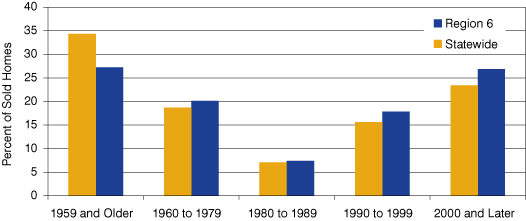
Source: IBRC, using Indiana Association of Realtors data
Looking at individual counties in the region, there is a significant spread based on the median age of homes sold in 2010 (see Figure 5).
Figure 5: Median Year Built for Homes Sold in 2010 by County in Realtors Region 6

Source: IBRC, using Indiana Association of Realtors data
In 2010, nearly 72 percent of homes sold in Realtors Region 6 were priced under $150,000, with no houses sold which were priced at $1 million or more. Using the state as a comparison, Region 6 had a higher proportion of homes priced between $50,000 and $199,000 (see Figure 6).
Figure 6: Cost of Homes Sold Compared to the State, 2010
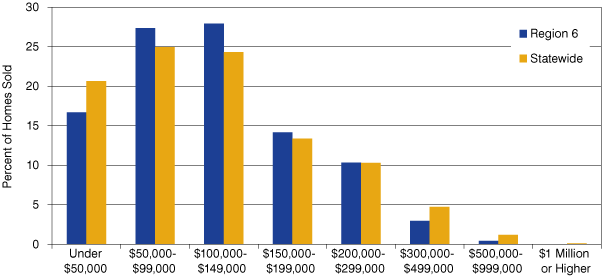
Source: IBRC, using Indiana Association of Realtors data
Labor Force
As seen in Figure 7, more than 339,000 residents of the region are part of the labor force, with 305,080 people employed and the remaining 33,979 actively seeking work (i.e., unemployed), based on 2009 annual averages.
The December 2010 unemployment rate for the region was 9.4 percent, slightly higher than the state rate of 9.1 percent for that same month (figures are not seasonally adjusted). For a closer inspection of labor force numbers, be sure to visit Hoosiers by the Numbers at www.hoosierdata.in.gov, the workforce data website of the Indiana Department of Workforce Development. These numbers are released monthly as preliminary estimates and are subsequently revised when the next month is released.
Figure 7: Realtors Region 6 Resident Labor Force and Employment, 1990 to 2009
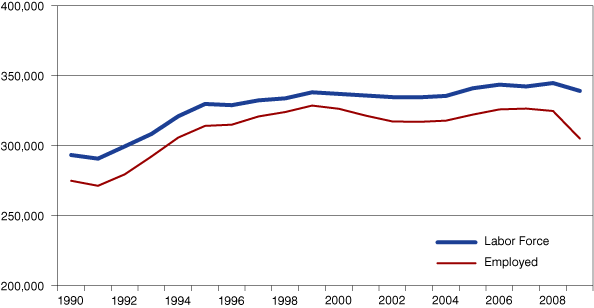
Note: Data are not seasonally adjusted.
Source: IBRC, using Indiana Department of Workforce Development data
Work
The vast majority of Region 6 residents work in private industry. The largest sectors include manufacturing, retail trade, and accommodation and food services (see Table 2).
Table 2: Realtors Region 6 Jobs by Industry, 2009
| Industry | Jobs | Jobs LQ |
|---|---|---|
| Total | 242,178 | 1.00 |
| Manufacturing | 51,186 | 2.30 |
| Retail Trade | 28,366 | 1.03 |
| Accommodation and Food Services | 20,646 | 0.93 |
| Health Care and Social Services | 17,986 | 0.52 |
| Transportation and Warehousing | 12,409 | 1.22 |
| Construction | 10,155 | 0.89 |
| Public Administration | 9,181 | 0.65 |
| Admin. and Support and Waste Mgt. and Rem. Services | 8,700 | 0.62 |
| Finance and Insurance | 6,738 | 0.65 |
| Other Services(Except Public Administration) | 6,117 | 0.72 |
| Educational Services | 5,858 | 0.24 |
| Wholesale Trade | 5,322 | 0.51 |
| Professional, Scientific, and Technical Services | 4,566 | 0.31 |
| Arts, Entertainment, and Recreation | 3,723 | 0.88 |
| Management of Companies and Enterprises | 2,865 | 0.91 |
| Information | 2,006 | 0.37 |
| Real Estate and Rental and Leasing | 1,898 | 0.45 |
| Utilities | 1,681 | 1.24 |
| Mining | 322 | 0.28 |
| Agriculture, Forestry, Fishing and Hunting | 304 | 0.14 |
Source: IBRC, using U.S. Bureau of Labor Statistics data
Jobs by Industry Cluster
Clusters can be a valuable way to organize our thinking about industry mix in an area. The Purdue Center for Regional Development has identified 17 industry clusters that give insight into the core industries and their supplier industries. The resulting data can help the region consider which are important or emerging clusters (see Table 3).
Table 3: Realtors Region 6 Industry Clusters, 2009
| Description | Cluster Employment | Industry Cluster Employment LQ |
|---|---|---|
| Total All Industries | 242,176 | 1.00 |
| Manufacturing Supercluster | 15,015 | 1.43 |
| Biomedical/Biotechnical (Life Sciences) | 7,648 | 0.87 |
| Transportation and Logistics | 6,719 | 0.97 |
| Forest and Wood Products | 6,265 | 1.60 |
| Education and Knowledge Creation | 5,959 | 0.25 |
| Business and Financial Services | 5,942 | 0.28 |
| Transportation Equipment Manufacturing* | 5,746 | 2.20 |
| Chemicals and Chemical Based Products | 4,732 | 1.23 |
| Fabricated Metal Product Manufacturing* | 4,398 | 1.78 |
| Energy (Fossil and Renewable) | 3,986 | 0.28 |
| Advanced Materials | 3,518 | 0.40 |
| Machinery Manufacturing* | 3,416 | 1.78 |
| Agribusiness, Food Processing and Technology | 2,915 | 0.50 |
| Printing and Publishing | 1,586 | 0.36 |
| Defense and Security | 1,475 | 0.12 |
| Primary Metal Manufacturing* | 1,347 | 1.97 |
| Information Technology and Telecommunications | 1,316 | 0.12 |
| Arts, Entertainment, Recreation and Vistor Industries | 1,288 | 0.13 |
| Glass and Ceramics | 633 | 0.75 |
| Computer and Electronic Product Manufacturing* | 58 | 0.03 |
| Electrical Equipment, Appliance and Component Manufacturing* | 53 | 0.08 |
| Mining | 31 | 0.09 |
| Apparel and Textiles | 20 | 0.01 |
*These are subclusters within the manufacturing supercluster.
Source: IBRC, using U.S. Bureau of Labor Statistics and Purdue Center for Regional Development data
In using the table, it’s worthwhile to consider the actual employment numbers shown and consider “how many” jobs comprise a particular cluster.
Another valuable measure is the location quotient (LQ) provided in the column next to the employment numbers. Anything over 1.0 means the region has what is considered export capacity—exporting to neighbors in another region, another state, across the nation or around the globe. The idea of producing “more than we need” indicates that those clusters are serving needs outside the region as well as within its borders. In short, having an LQ higher than 1.0 is good; if it is much higher, then the cluster can be considered substantial and is worth a closer look as part of an economic development strategy.
If clusters have piqued your interest, be sure to turn your browser to www.statsamerica.org/innovation to see these data in action for areas throughout Indiana and in comparison to the rest of the country.
Time to Explore
We hope to have given you a fast trek through the numbers. We could go on, but then that might spoil your fun in going to STATS Indiana’s IN Depth Profiles and learning more about this region or the whole host of regions we have available.
Carol O. Rogers
Deputy Director and Executive Editor, Indiana Business Research Center, Indiana University Kelley School of Business
Molly Manns
Associate Editor, Indiana Business Research Center, Indiana University Kelley School of Business

